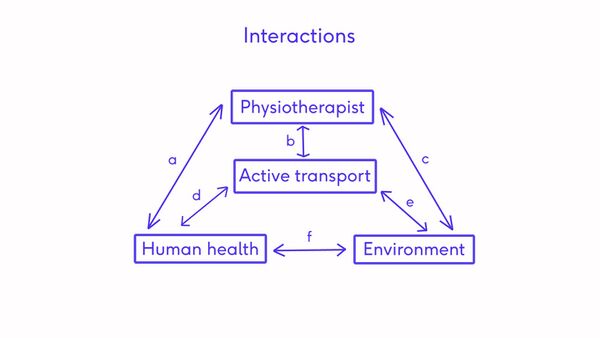Active Transportation and Planetary Health: Difference between revisions
Carin Hunter (talk | contribs) m (Protected "Active Transportation and Planetary Health": Course Page ([Edit=Allow only autoconfirmed users] (indefinite))) |
Carin Hunter (talk | contribs) No edit summary |
||
| Line 1: | Line 1: | ||
<div class="editorbox"> '''Original Editor '''- [[User:Carin Hunter|Carin Hunter]] based on the course by [https://members.physio-pedia.com/course_tutor/adam-toner/ Adam Toner]<br> '''Top Contributors''' - {{Special:Contributors/{{FULLPAGENAME}}}}</div> | <div class="editorbox"> '''Original Editor '''- [[User:Carin Hunter|Carin Hunter]] based on the course by [https://members.physio-pedia.com/course_tutor/adam-toner/ Adam Toner]<br>'''Top Contributors''' - {{Special:Contributors/{{FULLPAGENAME}}}} | ||
== What is Planetary Health? == | |||
Human health and our own existence depend on flourishing natural systems and that these stewardship of these systems and helping them thrive help us thrive to. Physiotherapy is widely recognised as being an important stakeholder in population health. Planetary health itself is seen as it's a growing and an important part of population health. | |||
== What is Active Transport? == | |||
Active Transport is defined as: | |||
* walking | |||
* cycling | |||
* scooters | |||
* jogging | |||
Active transport can be anything that involves physical activity to or from a place of work or school. If an individual uses public transport, walking or biking to that stop is defined as active transport. We see it as a planetary health intervention. If physiotherapy, as a profession, can help to increase active transportation, we might also see an increase in physical activity, which will simultaneously have a positive impact on the environment.[[File:Interactions Diagram.jpg|center|frameless|600x600px]] | |||
{| class="wikitable" | |||
|+ | |||
{| class="wikitable" | |||
|+ | |||
!Recommendations | |||
|- | |||
|Encourage active transport as a form of PA to improve individual and population health while yielding, additional health-related environmental benefits. | |||
|- | |||
|Educate physiotherapists and patients alike about the link between active transport, environment, personal and public health. | |||
|- | |||
|Advocate for safe and better infrastructure for active transport. | |||
|- | |||
|Advocate for more green spaces and less motorized streets without furthering socio-economic divides. | |||
|- | |||
|Advocate for active transport routes in close proximity to biodiverse green spaces, and blue spaces. | |||
|- | |||
|Advocate to make e-bikes and bike-share facilities more accessible to those populations that are unable to afford them but need them the most. | |||
|- | |||
|Advocate for better integration of active transport with sustainable public transport in a way that ensures physical and financial accessibility. | |||
|} | |||
!Interventions | |||
!Considerations | |||
|- | |||
| rowspan="4" |Encourage active transport to increase physical activity levels | |||
|Are patients open to learning about required physical activity levels? | |||
|- | |||
|Is active transportation cost-effective for the patient? | |||
|- | |||
|Are patients aware of local transportation links and bicycle routes? | |||
|- | |||
|Does the patient have safety concerns preventing active transport as an option as a result of their age, inability, gender, surrounding infrastructure? | |||
|- | |||
| rowspan="3" |Promote positive lifestyle changes through active transportation. | |||
|Could adopting active transportation increase the patient’s social interactions? | |||
|- | |||
|Could improved sleep occur as a result of increased activity levels? | |||
|- | |||
|Would adopting active transportation reduce stress in the patient’s life? | |||
|- | |||
| | |||
| | |||
|} | |||
</div> | |||
[[Category:Course Pages]] | [[Category:Course Pages]] | ||
[[Category:Environmental Physiotherapy]] | [[Category:Environmental Physiotherapy]] | ||
Revision as of 15:34, 30 June 2021
Top Contributors - Carin Hunter, Jess Bell, Wanda van Niekerk, Kim Jackson, Tarina van der Stockt, Lucinda hampton and Olajumoke Ogunleye
What is Planetary Health?[edit | edit source]
Human health and our own existence depend on flourishing natural systems and that these stewardship of these systems and helping them thrive help us thrive to. Physiotherapy is widely recognised as being an important stakeholder in population health. Planetary health itself is seen as it's a growing and an important part of population health.
What is Active Transport?[edit | edit source]
Active Transport is defined as:
- walking
- cycling
- scooters
- jogging
| Recommendations |
|---|
| Encourage active transport as a form of PA to improve individual and population health while yielding, additional health-related environmental benefits. |
| Educate physiotherapists and patients alike about the link between active transport, environment, personal and public health. |
| Advocate for safe and better infrastructure for active transport. |
| Advocate for more green spaces and less motorized streets without furthering socio-economic divides. |
| Advocate for active transport routes in close proximity to biodiverse green spaces, and blue spaces. |
| Advocate to make e-bikes and bike-share facilities more accessible to those populations that are unable to afford them but need them the most. |
| Advocate for better integration of active transport with sustainable public transport in a way that ensures physical and financial accessibility. |







